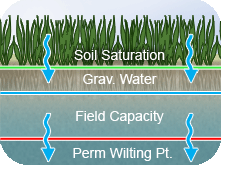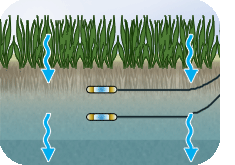
This mailer has been provided as an avenue of dispersing information related to landscape architecture in hopes of fostering greater understanding and collaboration between professions. Topics address issues that affect the built environment within which we live.
The Basics of Soil Moisture Sensing
"What we plant in the soil of contemplation, we shall reap in the harvest of action", Meister Eckhart
The purpose of any effective soil solution management program is to limit excessive applications of water and nutrients to the landscape; in essence saving time, money and effort. The basics for monitoring and managing levels of soil solution in any given soil can be complex, but a knowledge of the following three items is of greatest importance: soil properties, moisture demand from plants and the most appropriate method of taking measurements.
Soil Properties-The key to understanding and monitoring soil moisture levels is found in the properties of the soil. The following are a few of the many terms that any irrigation professional should be familiar with: Soil Texture, Gravitational Water, Field Capacity and Permanent Wilting Point.
 Soil Texture - Soil texture refers to the mineral content of the soil makeup (sand, silt and clay). Soils with high levels of sand in the soil hold less water and drain more rapidly than soils with high clay content which hold water molecules tightly and drain very slowly.
Soil Texture - Soil texture refers to the mineral content of the soil makeup (sand, silt and clay). Soils with high levels of sand in the soil hold less water and drain more rapidly than soils with high clay content which hold water molecules tightly and drain very slowly.
Gravitational Water - This is the volume of water between soil states of saturated soil and when water percolation rates slow dramatically.
Field Capacity - This term refers to the soil state when water percolation has effectively stopped and moisture is still readily available for plant consumption.
Permanent Wilting Point -This condition is defined as the point when soils no longer have available moisture for plant growth. Water is limited to a degree that plants will not recover, even when water is applied.
Moisture Demand- Moisture demand is directly related to the type and species of the plants planted in the soil. A high water-use plant and low water use plant in the same soil will reach permanent wilting point at different times because the needs and demands for life sustaining water differs. In order to maintain a healthy level of moisture in the soil a manager will need to know the plant's water needs, typical rooting depths, growth cycles and seasonal moisture needs. Given this information, irrigation cycles and methods can be adjusted and refined resulting in an appropriate use of water, healthier plants and less leaching of nutrients from the soil.
 Measuring Moisture- There are many methods of measuring the levels of moisture in the soil. Some are more accurate than others, some produce real-time results and others are restrictive due to high levels of labor or cost. The following is a short breakdown of the most common monitoring methods for ornamental landscapes.
Measuring Moisture- There are many methods of measuring the levels of moisture in the soil. Some are more accurate than others, some produce real-time results and others are restrictive due to high levels of labor or cost. The following is a short breakdown of the most common monitoring methods for ornamental landscapes.
Tensiometers - These devices measure the tension or suction of the soil, effectively measuring the difficulty roots will have to extract water from the surrounding soil. This measurement is taken through the use of a plastic tube and a porous ceramic tip. Readings on these devices are read manually, no data is transmitted to a control system. These devices are more accurate than many devices (particularly in sandy soils (provided there is good soil to device contact). They do however require regular maintenance and need to be filled with water.
Electrical Resistance blocks -These devices measure soil moisture tension in the nearby soil through two electrodes in a porous shell, often gypsum. The shell or block absorbs and releases moisture from nearby soils and the electrodes measure resistance to electrical currents at pre-determined intervals. Unfortunately these devices also require maintenance and need to be replaced often.
Electrical Conductivity Probes-These probes measure soil moisture in essentially the same manner as the electrical resistance blocks, except they are not encapsulated by a block or shell. The probes are installed with direct soil contact. The same method of measuring electrical current resistance is used. In this case, the sensors are subject to inaccuracies due to salts and fertilizers in the soil solution. These sensors tend to be less effective in sandy soils where preserving constant direct contact with sensors is difficult.
Dielectric Sensors - Similar to electrical conductivity probes, these sensors are installed in direct contact with the soil. There are two different measurement methods that can be used with these types of probes. One type emits a frequency into the soil that is then measured. The other method measures the rate at which signals travel through soil. Both of these methods require on-site calibration of the sensors. With proper calibration, these sensors are more accurate than other methods of moisture measurement, but tend to be much more expensive.
As is often the case, there are pros and cons to the selection of each monitoring method. With guidance from a professional, an educated decision can be made. Then with additional knowledge of soil properties and moisture demands, appropriate levels of management can be provided.
Prior Issues of Interest
- Universal / Inclusive Design - Part 1- Playgrounds
- Universal / Inclusive Design - Part 2 - Walks and Trails
- Playground Safety: What's the Big Deal?
- Artificial Turf: A Pros & Cons Review
- The Vestibular and Proprioceptive Sensory Systems
Click the video below to visit our YouTube channel and see a short clip on the grand opening of White Rock Park in Rancho Cordova.
References:
1-Enciso, Juan M., Dana Porter and Xavier Perles. Irrigation Monitoring with Soil Water Sensors. Texas Cooperative Extension. B-6194. January 2007.
2-Hansen, Blaine R., Douglas Peters and Steve Orloff. Effectiveness of Tensiometers and Electrical Resistence Sensors Varies with Soil Conditions. California Agriculture 54(3):47-50. DOI:10.3733/ca.v054n03p47. May–June 2000.
3- Mecham, Brent Q. A Practical Guide to Using Soil Moisture Sensors to Control Landscape Irrigation. Northern Colorado Water Conservancy District. Loveland, CO.
Author: Chad Kennedy, Landscape Architect
This informational article provided by O'Dell Engineering - 1165 Scenic Drive, Suite A, Modesto CA 95350
